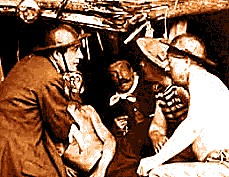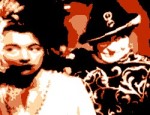Film Review

Capellani's inspired adaptation of Émile Zola's classic novel Germinal, first released in 1913, is testament to both the director's artistic powers and the confidence that Pathé had in him. Running to two hours in length, this was a blockbuster production of the kind that was virtually unheard of at the time, and its phenomenal popularity not only shored up Capellani's reputation, it also ensured that the feature film would soon become cinema's main attraction. Prior to this, Capellani had directed another impressive Zola adaptation, L'Assommoir (1909), and a superlative attempt at another monumental work of French literature, Les Misérables (1913). With an ample budget that allowed him to construct massive sets and hire a cast of hundreds, Capellani was allowed to do what few other filmmakers had been able to do prior to him - to deliver screen interpretations of familiar novels that more than did justice to the original material, and without looking like filmed stage plays.
It is now over a hundred since Capellani's Germinal was made but it still continues to impress with the sheer scale of its ambition. You only have to watch more recent adaptations of the novel - one by Yves Allégret in 1963, another by Claude Berri in 1993 - to see what difficulties adapting this sprawling epic of a novel presents, even to accomplished filmmakers. Without recourse to the kind of special effects that film directors now take for granted, Capellani had an almighty challenge realising the novel's famous set-pieces, notably the flooding of the mine at its apocalyptic climax. Unable to film in a real mine for safety reasons, Capellani had to construct full-size mock-ups of the mining galleries in the studio, and these are so well constructed and so carefully shot that you could hardly fail to mistake them for the real thing.
Albert Capellani's particular forte was creating powerful compositions which bring home the drama and poignancy of his subject without resort to the kind of melodramatic sleights of hand that less capable directors tend to fall back on. Germinal abounds with examples of this. The stand-off between the miners and the armed militia (eerily reminiscent of a similar scene in Sergei Eisenstein's Battleship Potemkin, made twelve years later) and its solemn aftermath serve up some stark images that stay lodged in your head for long after you have watched the film. A street brawl involving the hero Lantier and his romantic rival has a fierceness that you would hardly expect for a film of this era, but for visual impact and shock value nothing surpasses the scene of utter devastation in the flooded mine at the film's climax.
Capellani wasn't only a master of shot composition, he was also extremely good at getting the best from his actors, and this is apparent in the lead performances from Henry Krauss and Sylvie (Louise Mainguené), who contribute a great deal to the film's dramatic impact. Krauss had been a magnificent Jean Valjean in Capellani's Les Misérables, but, with his powerful physique and ability to convey real emotion through subtle gestures, he is equally well suited for the role of Étienne Lantier, the impulsive thug with a tender heart. Many French film enthusiasts will know Sylvie from the films she appeared in in her later years - she had a memorable part in H.G. Clouzot's Le Corbeau (1943) and played Charles Trenet's mum in Romance de Paris (1941). To see her in Germinal as the heroine Catherine, a feisty 30-year-old who looks so butch that we easily mistake her for a man when we first see her in her mining attire - is quite a shock. The fact that Sylvie portrays Catherine as such a strong, almost masculine, character makes her brutal demise all the more tragic. Both lead actors defy the stereotypical norm of the handsome screen lover and instead bring an earthy realism to their portrayals that makes the drama all the poignant and involving.
What is most striking about Capellani's Germinal is how, for a film of this era, unrelentingly grim and violent it is. Much nearer to social realism than melodrama, there is a fierce, almost sadistic brutality to the film that very nearly surpasses that of Zola's writing at its most pessimistic. With so much of the action filmed on location - in a typically dreary northern French mining town (Auchel), and in the near-documentary, coldly realist style that was favoured by Capellani - the film was unlikely to end up looking like a musical comedy, but you can't help but be taken aback by how crushingly gloomy it is for pretty well its entire duration. (The only moment of light relief is a scene at a fairground where a casual passerby looks curiously at the camera, before slipping out of shot when he realises he is being filmed. Could this be the earliest instance of the 'fourth wall' being broken in a film drama?) The heavy oppressiveness that clings to the forlorn exteriors of the mine is even more apparent in the claustrophobic mining galleries. The mining works that Capellani creates come to resemble the frightening Moloch machine in Fritz Lang's Metropolis (1927) - an insatiable sacrificial temple to capitalism. And with this sense of unremitting oppression there is a continual ratcheting up of the tension, so that when the cataclysmic shocks come - like a series of avalanches at the film's climax - they have a terrible inevitability about them. If you thought Zola's novel was grim, this adaptation is unlikely to alter that impression one iota.
© James Travers 2016
The above content is owned by frenchfilms.org and must not be copied.
Film Synopsis
In 1860s France, an unemployed railway worker, Étienne Lantier, arrives in the bleak mining town of Montsou in the north of France and finds work as a miner. He takes lodgings with the hard-up Maheu family and finds himself strongly attracted to the daughter of the household, Catherine, who also works in the mine. Realising he has a rival, Catherine's present lover Chaval becomes jealous and gets into a fight with Lantier. As the economic conditions worsen, the mine's owner Hennebeau insists on cutting the pay of his workers, but this merely aggravates tensions between himself and the miners. Lantier convinces his fellow miners that they have no choice but to go on strike. Unfortunately, knowing he has the law on his side, Hennebeau is determined not to be beaten...© James Travers
The above content is owned by frenchfilms.org and must not be copied.
Similar Films
Here are some other films you may enjoy watching:Film Credits
- Director: Albert Capellani
- Script: Albert Capellani, Émile Zola (novel)
- Photo: Louis Forestier, Pierre Trimbach
- Cast: Mévisto (Maheu), Jean Jacquinet (Chaval), Henry Krauss (Etienne Lautier), Sylvie (Catherine), Paul Escoffier (Négrel), Dharsay (Souvarine), Albert Bras (Hennebeau), Jeanne Cheirel (la Maheude), Cécile Guyon (Cécile Hennebeau), Marc Gérard (Bonnemort), Léon Bernard, Paul Capellani
- Country: France
- Language: French
- Support: Black and White / Silent
- Runtime: 150 min
- Aka: The Toll of Labor
Continental Films, quality cinema under the Nazi Occupation

French cinema during the Nazi Occupation

The very best fantasy films in French cinema
